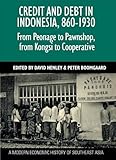Credit and Debt in Indonesia, 860-1930 : From Peonage to Pawnshop, from Kongsi to Cooperative / ed. by David Henley, Peter Boomgaard.
Material type: TextPublisher: Singapore : ISEAS Publishing, [2009]Copyright date: ©2009Description: 1 online resource (200 p.)Content type:
TextPublisher: Singapore : ISEAS Publishing, [2009]Copyright date: ©2009Description: 1 online resource (200 p.)Content type: - 9789812308467
- 9789812308474
- 330.09 22/ger
- HG3754.5.I5 C74 2009
- online - DeGruyter
| Item type | Current library | Call number | URL | Status | Notes | Barcode | |
|---|---|---|---|---|---|---|---|
 eBook
eBook
|
Biblioteca "Angelicum" Pont. Univ. S.Tommaso d'Aquino Nuvola online | online - DeGruyter (Browse shelf(Opens below)) | Online access | Not for loan (Accesso limitato) | Accesso per gli utenti autorizzati / Access for authorized users | (dgr)9789812308474 |
Frontmatter -- Contents -- Preface -- Contributors -- 1. Credit and Debt in Indonesian History: An Introduction -- 2. Preliminary Notes on Debt and Credit in Early Island Southeast Asia -- 3. “Following the Debt”: Credit and Debt in Southeast Asian Legal Theory and Practice, 1400–1800 -- 4. Credit among the Early Modern To Wajoq -- 5. Money in Makassar: Credit and Debt in an Eighteenth-Century VOC Settlement -- 6. Money and Credit in Chinese Mercantile Operations in Colonial and Precolonial Southeast Asia -- 7. A Colonial Debt Crisis: Surabaya in the Late 1890s -- 8. Credit and the Colonial State: The Reform of Capital Markets on Java, 1900–30 -- Appendix -- Index
restricted access online access with authorization star
http://purl.org/coar/access_right/c_16ec
Credit and debt are practical concerns of all times and places. They are also increasingly important topics in economic history and the social sciences, from Marcel Mauss and the anthropology of the gift to the urgent quest for understanding of today's global credit crunch. This volume brings together eight essays on credit and debt in the history of Indonesia, where for centuries debt and debt bondage played central roles in the organization of society, and where efforts to combat 'usury' and free peasants from indebtedness were central to the ethical and nationalist movements of the late colonial period. Topics range from the inscriptions of ninth-century Java to the first global financial crisis in 1930, and from Islamic laws against the charging of interest to the role of Chinese temples and Dutch church charities as credit providers. The history of credit and debt in Indonesia is examined from a wide variety of perspectives - legal, institutional, and cultural as well as economic. Attention is paid to parallels and contrasts with more recent developments, including the Asian financial crisis of 1997 and Indonesia's rise to fame as a pioneer of the current global microfinance revolution.
Mode of access: Internet via World Wide Web.
In English.
Description based on online resource; title from PDF title page (publisher's Web site, viewed 01. Dez 2022)


